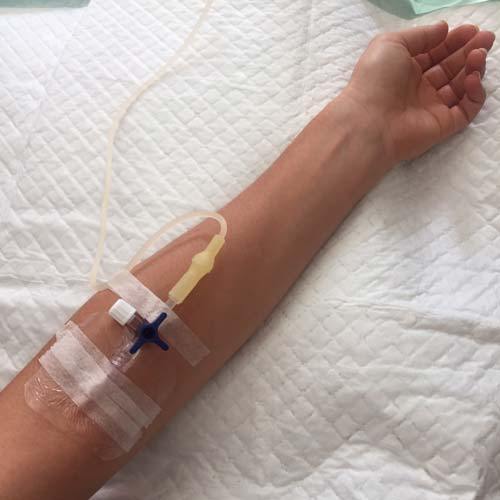(By Rabbi Yair Hoffman for 5TJT.com)
For some reason, not-withstanding the proliferation of Halacha hotlines, it is getting harder and harder to get hold of a Rav or Posaik during a critical time. One very common question that comes up for couples involves induction of labor (as opposed to waiting for labor to occur naturally) by giving, among other things, a drug called Pitocin in the labor and delivery room. Pitocin is a synthetic version of Oxytocin, believed to be the body’s own labor-stimulating hormone.
Inducing labor with Pitocin involves delivery through an IV in the patient’s arm. The nurse gradually raises the level of Pitocin until there are regular contractions coming every two to three minutes or so.
HALACHIC PARAMETERS
But what are the halachic parameters as to when and when one may induce?
Rav Moshe Feinstein zt”l writes in Igros Moshe YD Vol. II #94 that one should not induce labor unless it is medically indicated. One reason is that a person should wait for Hashem to bring the baby at its proper time. If there exists a concern for the welfare of either the baby or mother, both Dayan Vozner zt”l (Shaivet HaLevi YD Vol. VI #128) and Rav Ovadiah Yoseph (Taharas Habayis Vol. II p. 54) rule that one may do so.
THE THREE KEYS
The backing to the idea of not precipitating the birth earlier is based upon a Gemorah in tractate Taanis 2a. The Gemorah states that there are three keys that Hashem handles directly and not through an angel: Those are birth, rains, and Tchias HaMaisim. Tosfos in Niddah 16b states that there is no malach (ANGEL) that is appointed over the timing of the birth. Apparently, since it is Hashem Himself that oversees it – there is greater reason to avoid precipitating an earlier birth. This, however, should never be employed when there can be any danger to the mother or child at all. The Torah tells us “v’Chai Bahem- and you shall LIVE by them and not die by them.” We must never endanger a woman or child when there is medical necessity.
But even in the secular world there is an idea of “if it ain’t broke – don’t fix it.” Unless an induction is medically necessary, many people (and clinicians, both doctors and midwives) prefer to let nature happen on its own.
So what might be the medical necessities that warrant early induction? One should, of course, never rely on print or internet articles for one’s halachic rulings. But it is a good idea to become familiar with these issues and speak to one’s own Rav or Posaik for guidance as to these parameters.
From a medical point of view (but check with your provider), any risk of polyhydramnios, pre-eclampsia, fetal growth restriction, diabetes, and other birth complications would warrant it.
Rochel Lieberman of South Shore Midwives, one of the leading practitioners of midwifery in Five Towns and Long Island, tells the Five Towns Jewish Times, “ ACOG now recommends that pregnancies of women age 40 and above should not go past 40 weeks – which is how the initial due date is calculated, and therefore, might also warrant an induction of labor. If the water has broken but labor has not yet started, if the pregnancy is more than two weeks overdue or if the labor has stalled or stopped midway then it is likely that the doctor or midwife may introduce the drug too.”
NATURAL MEANS OKAY
It should be noted that natural means of inducing earlier labor are permitted: This includes walking during pre-labor, use of homeopathic remedies or other natural types of stimulation. The Steipler Gaon would advise people of this.
Rochel Lieberman advises that this should not be done for the general convenience of the doctor or midwife, nor to get a tax benefit of a December 31st birth. It should also not be done to be able to watch the SuperBowl, nor to be featured as the first child born in the secular year.
OTHER TIMES
But what if the more experienced provider is about to leave the hospital and someone else is scheduled to take over? Some Poskim only permit it– when it is considered a higher risk pregnancy. If it is not high risk – then they do not permit it (See Rav Yitzchok Zilbershtein in Toras HaYoledes 1:1-2 – unless the mother is connected to and/or set upon the first doctor). Others are more lenient (See Sefer Pu’ah p. 64 citing Dayan Fisher zt”l’s brother, Rav Shlomo Fisher).
What if the current provider is kind of droopy-eyed and seems to be getting tired? Rav Zilberstein permits it only when there is no other clinician who can take over.
If the woman is nervous because of the particularly youthful appearance of the second doctor or midwife, it seems to this author that it would be permitted as well. This is based on the idea that one is permitted to violate Shabbos in the case of active labor in order to appease the mother in active labor.
NO NEED FOR PRESENT DANGER
It should be noted that one does not have to wait until there is a clear and present danger. Even if there is a significant chance of danger – then one may clearly introduce the Pitocin. It should be noted that Pitocin is usually not the first-line drug that is given. There are other medications that first help prepare the body for delivery. They are introduced through a different route, and their mechanism of action is also different. These medications are usually used to prepare the woman’s body so that it is inducible afterwards with Pitocin, and makes for a more successful overall induction of labor.
There are a number of benefits to the use of Pitocin, when used judiciously, advises Rochel Lieberman. It seems to reduce the risk of a C-section delivery, because it increases the chances of having a normal birth, according to a study published in the Canadian Medical Association Journal.
THE RISKS
There are also some risks involved with a Pitocin induction.
There is greater risk of infection, as well overstimulation and/or rupture of the uterus. There is also the risk of fetal distress and/or a drop in the fetal heart rate. That is why the mother and baby must be strictly monitored during the duration of the induction, throughout the time that the Pitocin is on board.
There is also the rule that one is not allowed to eat. This is because of the risk of aspiration under anesthesia in an emergency cesarean delivery. Pitocin contractions are also stronger, last longer, and are often more challenging to endure, and could interfere with rest.
But as mentioned earlier, one should consult with one’s Posaik and Rav prior to the actual labor so that the guidelines are clear. May all those that are expecting deliver b’sha’ah tova umutzlachas.
The author can be reached at [email protected].
(YWN World Headquarters – NYC)











